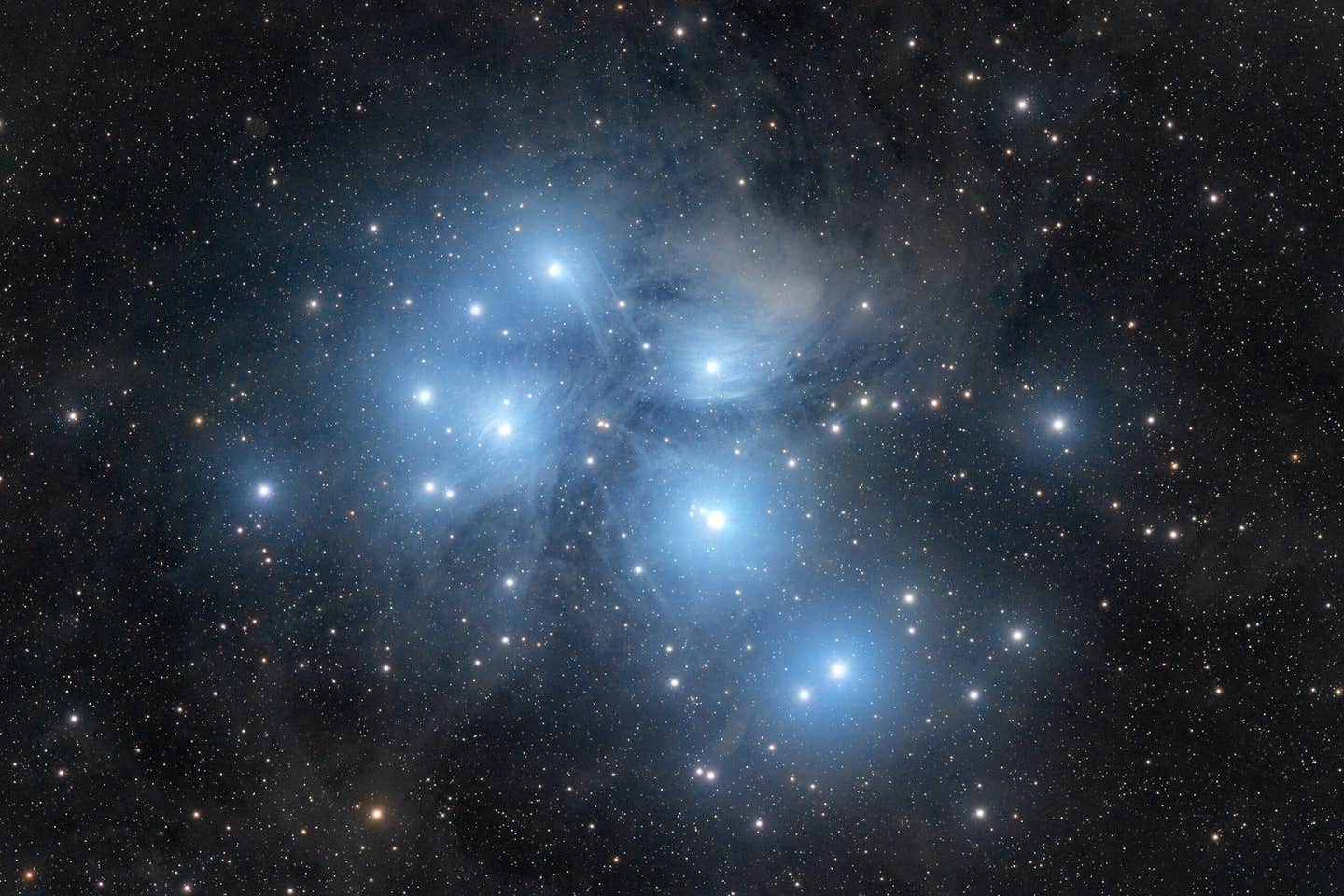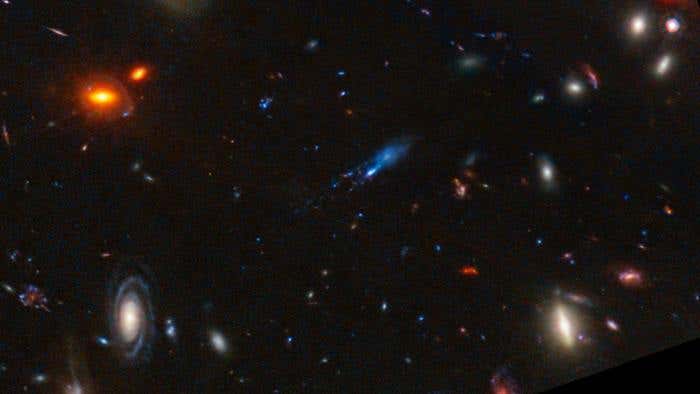The Seven Sisters (Pleiades) are part of a vast 2,000-light-year stellar network
Astronomers uncover the Greater Pleiades Complex, a vast 2,000-light-year network of related stars in the Milky Way.

 Edited By: Joseph Shavit
Edited By: Joseph Shavit

The Pleiades, long admired as the Seven Sisters, are only the bright core of a much larger stellar family stretching nearly 2,000 light-years across the Milky Way. (CREDIT: Shutterstock)
On a brisk, dark evening, the Pleiades twinkle like a small handful of stars scattered across the sky. To the human eye, this bright cluster—often referred to as the Seven Sisters—appears small and compact. New research shows that what you see is only a small part of a massive and ancient stellar family stretching about 2,000 light-years across the Milky Way.
A research team led by Andrew Boyle and Andrew Mann at the University of North Carolina-Chapel Hill, along with Carnegie astronomer Luke Bouma determined that the Pleiades are merely the dazzling core of a broad association of thousands of stars. Using data from NASA's TESS mission, ESA's Gaia spacecraft, and the Sloan Digital Sky Survey, the scientists reconstructed what they called the "Greater Pleiades Complex" to create a panoramic view of stars in their field.
It contains at least three previously known groups of stars—likely two more—Bouma said. We were able to determine that most of the members of this structure arose from the same enormous stellar nursery.
Unraveling the Origins of the Seven Sisters
Stars are born together in enormous clouds of dust and gas. Over time, the stars disperse from their shared birthplace, and gravity from the galaxy itself pulls them apart. Within a few hundred million years, most clusters lose their structure. Members wander through space so widely that it becomes nearly impossible to trace their family connections.
The researchers wanted to answer this dilemma using a combination of precise motion data from Gaia and light measurements from TESS. Gaia is responsible for the identification of the location and motion of a star, while TESS is revealing small dips related to dark starspots that are rotating in and out of view. Those measurements can yield Her starlit spin rate, which is also a proxy for Her age.
Younger stars spin rapidly, and older stars slow down. Hence, the relationship between rotation and age, termed gyrochronology, can be relied upon by astronomers to produce an "age" of a star long after the evidence of its birth clouds has dissipated.
Boyle likens this process to creating a cosmic jigsaw puzzle, stating, "Just on its own, data from each mission was not enough to build the full extent of the structure...but when we tied it all together—stellar motions from Gaia, rotations from TESS, and chemistry from SDSS—everything came together".
Detecting a Hidden Galactic Network
To find possible siblings of stars to the Pleiades star is relatively simple, although the team is studying approximately 7.8 million stars within 500 parsecs of Earth, shortening the glory star to only those stars that are moving together in the Pleiades orientation and have the same spin rate, which leaves us with about 3,100 stars with the same age, motion, and chemical composition.
When these stars come together, they create an enormous structure, nearly 600 parsecs across, with the Pleiades being the most dense star. And while a single star may appear to us as one object in the night sky, it is simply one star in a great, slowly dispersing network of siblings.
Within this framework are several recognized groups, specifically UPK 303, HSC 1964, and the AB Doradus moving group, as well as two new regions referred to as GPC-1 and GPC-2. The researchers performed detailed orbital simulations to retrace portions of these subgroups forward in time to show some of them passed close to the birthplace of the Pleiades about 120 million years ago.
“The Pleiades have been a central part of human observations of the stars for thousands of years,” Bouma said. “This is a significant stride to understanding how we relate to the Pleiades group since its birth approximately one hundred million years ago.”
A New Approach to Reconnect Lost Star Families
The main innovation of the study is the use of a Bayesian “gyro-tagging” method, a way to determine how probable it is that a star belongs to a specific group by weighting rotation speed, temperature, and motion. This method helps researchers identify true family members from the glut of unrelated stars in the galaxy.
The study further confirmed that stars within the Greater Pleiades Complex locally share not only ages and motions, but also similar chemical fingerprints. Using chemical data from the Sloan Digital Sky Survey, led by Carnegie’s Juna Kollmeier, the researchers established that these stars formed from a common original material.
By placing a location for these stars now and measuring how they are moving, astronomers can rebuild how the cluster evolved. The once tightly bound Pleiades core is wrapped in a huge halo of dispersed siblings, proof of the powerful forces that mold star families over millions of years.
Practical Implications of the Research
This discovery profoundly alters the way people observe the night sky. What was seen as a small cluster of bright stars is now understood to be the visible heart of a massive galactic family. Moreover, it provides, beyond a deeper understanding of stellar evolution, a methodology to trace the origins of countless other stars.
By creating a three-dimensional object to track light, motion, and chemistry, astronomers would now be able to identify groups of stars that share some history, even if their clusters have completely dissolved. This may help not only map the Milky Way's budding structure, but may also provide where and how our own Sun was formed and drifted far away from its birth cloud.
It will take time, but hopefully, the same system could solve the lost extended relatives of other famous clusters and could help map the extensive web of connections of stars scattered throughout the Galaxy.
Research findings are available online in the journal The Astrophysical Journal.
Related Stories
- Astronomers discover a galaxy making stars 180x faster than the Milky Way
- Orion, Pleiades, and Hyades are snapshots of the same star cluster across 800 million years
- New model reveals how supermassive stars shaped the early universe
Like these kind of feel good stories? Get The Brighter Side of News' newsletter.
Mac Oliveau
Science & Technology Writer
Mac Oliveau is a Los Angeles–based science and technology journalist for The Brighter Side of News, an online publication focused on uplifting, transformative stories from around the globe. Passionate about spotlighting groundbreaking discoveries and innovations, Mac covers a broad spectrum of topics—from medical breakthroughs and artificial intelligence to green tech and archeology. With a talent for making complex science clear and compelling, they connect readers to the advancements shaping a brighter, more hopeful future.



